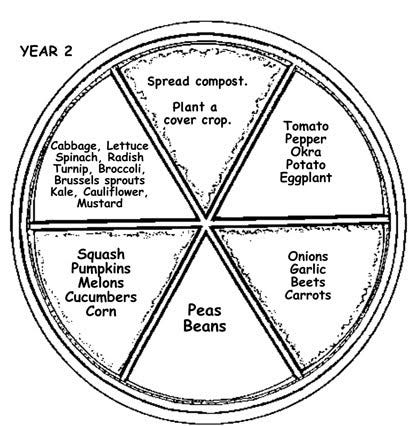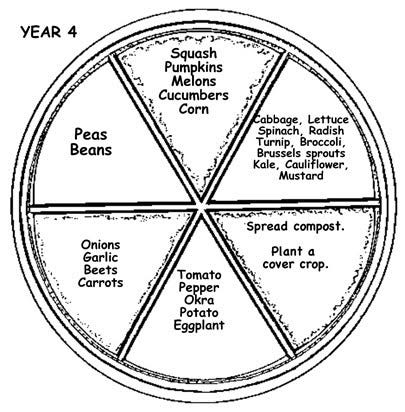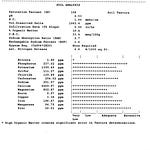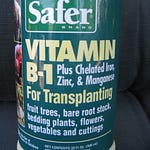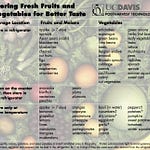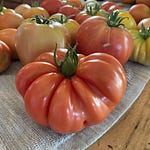In this interview with America’s Favorite Retired College Horticulture Professor, Debbie Flower, we discuss how to stave off plant diseases and insect pests by rotating your crops. And heck, if you’re gonna rotate, it might as well resemble a wheel, right? This interview originally aired in Episode 114 of the Garden Basics with Farmer Fred podcast.
I have little or no artistic sense whatsoever, especially in the garden. I tend to plant in rows, in rectangular raised beds, all designed for function, not form. With raised boxes, it's easier to rotate the vegetables each year.
But only IF you can remember what was planted where, the year before. A circle garden, on the other hand, might be easier to rotate crops than a scattershot series of raised, rectangular beds.
The benefits to crop rotatation? Many of the plants that are in the same "family group" have diseases in common. Many of these diseases are difficult, or impossible, to control using chemicals. For example, don't plant tomatoes in the spot where you had potatoes last year, and vice versa. That could spread late blight disease. The best solution for disease control is crop rotation.
Of course, choosing resistant varieties of vegetables can help thwart diseases. For example, tomatoes with a "V" "F" and/or "N" after their names indicates resistance to verticillium wilt, fusarium wilt and nematodes. However, most heirloom varieties of vegetables offer little or no disease resistance...another good argument for crop rotation. For heirlooms, choose those varieties that are meant to grow in the area you live. And, it helps to spread an inch or two of compost over all your garden beds before you plant each year.
Another advantage of having a series of garden beds in the same area: each crop can be irrigated according to its specific needs. For example, as onions and garlic mature in May, watering should be reduced. But that is also the time that summer crops such as tomato and pepper plants need regular watering. An automatic drip irrigation system, with individual lines for each bed, can customize the amount of water for each bed. In my dream circular garden, the valves can be centrally located in the “hub area” - Where all the beds come together -for ease of operation. Individual drip lines then would run to each bed, where on-off valves can be located for each bed.
Another reason for crop rotation: to replenish nutrients to the soil. Many vegetables tend to be heavy nitrogen users. Giving your soil an "off-year" every few years by planting cover crops allows it a chance to reduce pest populations while building up valuable soil nutrients, as well as beneficial fungi and bacteria.
Annual cover crops that do well in USDA Zone 9 for the warm weather seasons: buckwheat, cowpeas, soybeans and black eye peas.
For the cool weather seasons in USDA Zone 9: bell or fava beans, winter peas, vetch, clover. All of these can add more nitrogen to the soil.
An excellent online reference for cover crops: the Peaceful Valley Farm Supply Catalog. That publication also points out several other benefits to crop rotation:
• Increases organic matter
• Increases earthworms and beneficial microorganisms
• Stabilizes soil to prevent erosion
• Brings deep-rooted minerals to the surface
• Provides habitat, nectar, and pollen for beneficial insects while choking out weeds
• Improves water, root and air penetration of soil
• Increases the soil’s moisture-holding capacity
• Breaks up subsoil and plow-soles
• Provides aesthetic value and color (artistic!)
Which brings us back to my original quandary...how to remember exactly what was planted where, each year. Garden gnomes (cleverly disguised as possums) steal the signs; leaving crop remnants in each bed could add to pest and disease problems; writing down the location of crops each year would work...if you remember to go back in the house to check your garden notebook before starting the task of planting each year (ha!).
One solution that may work is a circular garden, consisting of six raised beds formed to look like spokes emanating from a hub, like a bicycle wheel, for example. Perhaps a pizza garden would be a more appropriate name for this wheel of edibles.
There are definite benefits to having a garden in the shape of a circle: a central water source in the middle of the circle, perhaps a small tool shed in that hub area, and compacted walkways three or four feet wide (big enough for a wheelbarrow) to avoid stepping on the garden soil or squeezing between the sides of the raised beds. Make those pathways wider if you want to drive a small tractor with a bucket up those pathways. And, you’ll need room in the middle to turn around or navigate your way out. So, that middle circle at the hub - which would hold water valves, a faucet, small tool shed, a recirculating bird bath (Hey! Let me dream, will you?), and room to navigate your little orange Kubota around - might need a diameter of 12-15 feet. The length of each slice of this pizza garden should be about 20 feet, with the outer edge of each piece being about four feet wide, to easily reach the middle of each slice to pull weeds, plant, and harvest. Please, any reader with graph paper or a landscape computer program: figure out the ultimate size of this six slice pizza garden for me. I’ll start looking on Zillow for acreage.
Seems like a lot of work to just have an easier way to remember to rotate crops each season. But it would be really cool to look at from the roof of the house. Or a drone video.
Here's the general idea for the Circular Crop Rotation Garden. The crops are arranged so that every three years, the soil gets a break: either nitrogen-fixing crops such as peas and beans are planted; or, a cover crop and compost are added to replenish the soil. Also, crops that tend not to be heavy nitrogen users are situated right before the "rest year". In this case, root crops and leafy crops precede beds that are in minimal use (cover crops or peas/beans). The heavy nitrogen-using beds are directly opposite each other: tomatoes, peppers, etc. are opposite the corn and cucurbits.
More info at the Farmer Fred Rant Blog Page, “It’s Crop Rotation Time! Do You Have the Room?”
Thank you for listening to the Garden Basics with Farmer Fred podcast! It’s available wherever you get your podcasts. Please share it with your garden friends.
As an Amazon Associate, I earn from qualifying purchases from some of the underlined links in the newsletter. This is how I am trying to keep this a free newsletter. And as long as you buy whatever you want from Amazon using any of those links to get into the Amazon site, I get a few pennies. Thank you.
Thanks for Subscribing and Spreading the Word About the Beyond the Basics: The Garden Basics with Farmer Fred newsletter, I appreciate your support.
Fred Hoffman is also a University of California Cooperative Extension Master Gardener in Sacramento County.










